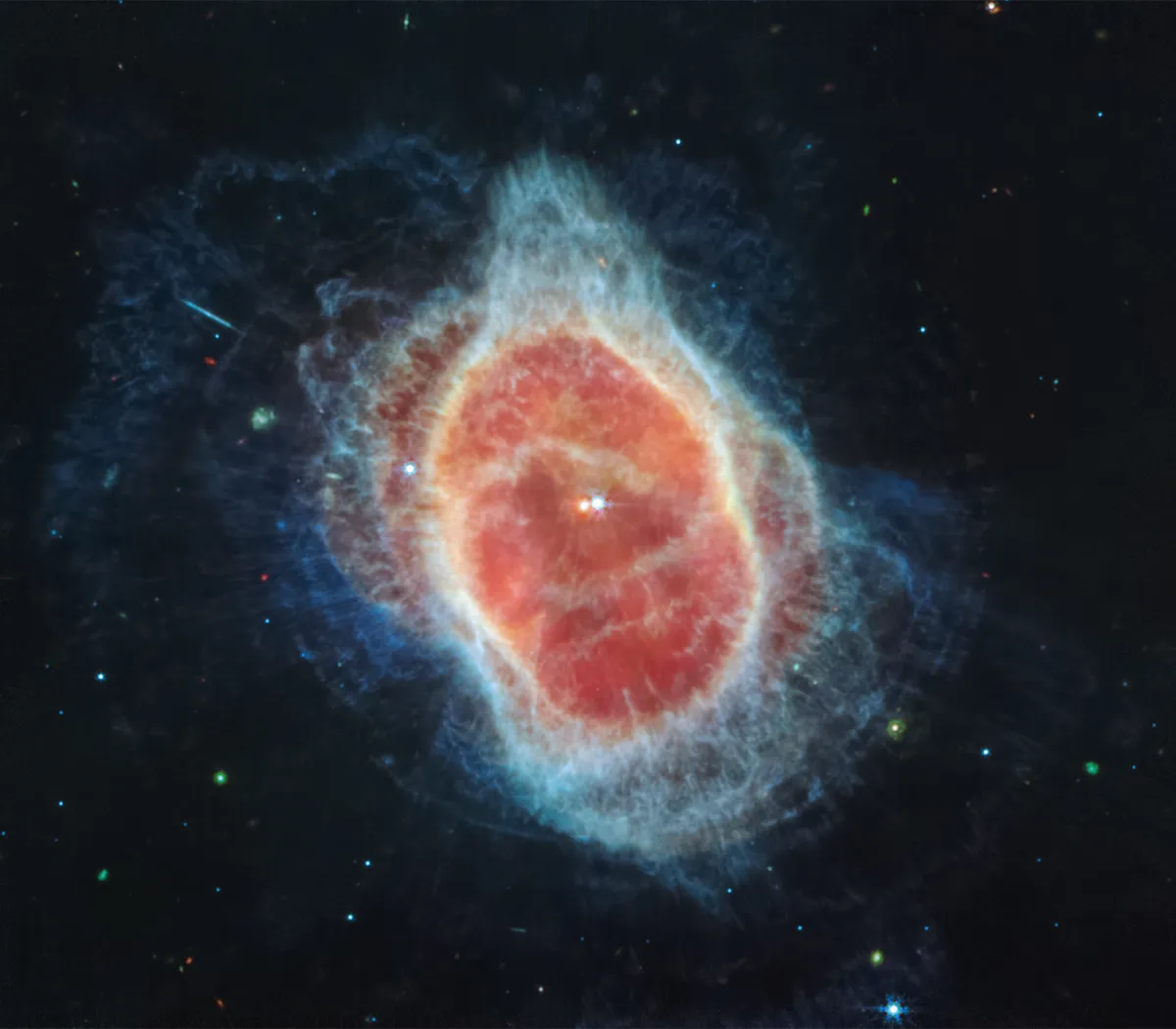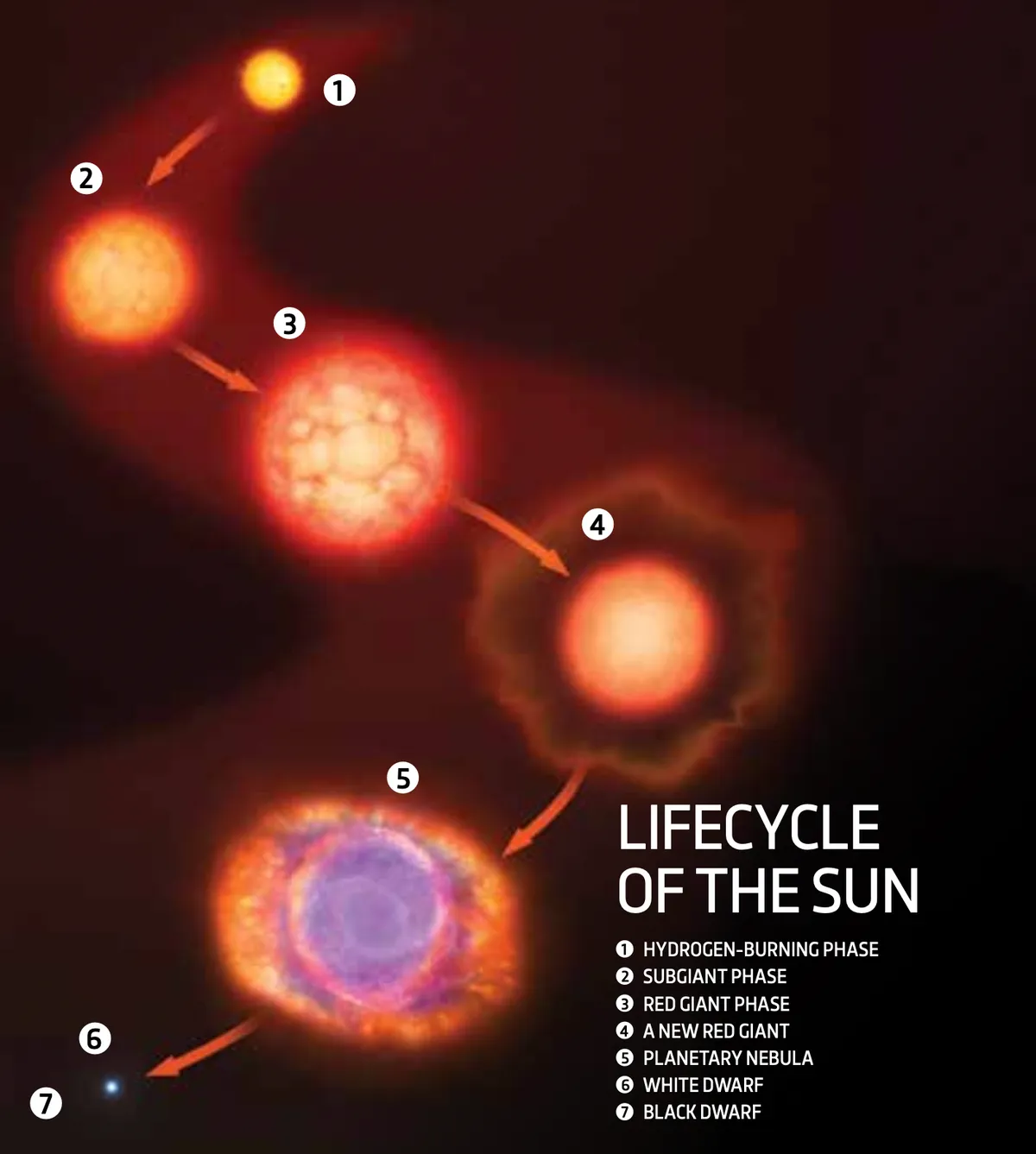The Sun formed about 4.6 billion years ago and is set to survive in its current state, roughly speaking, for another 4.5 – 5.5 billion years. And while we can’t predict what will happen in billions of years to come, knowledge of how stars evolve has enabled astronomers to broadly infer how the Sun’s life is likely to play out. More massive stars may end their lives in an explosion known as a supernova, but that is not the likely scenario that awaits our own.
1. Hydrogen-burning phase
Every second the Sun converts 600 million tonnes of hydrogen into four million tonnes of energy: the rest is converted into helium ‘ash’. Throughout its life the Sun’s energy output has continued to increase, and it is thought to have grown 30 per cent brighter in the 4.6 billion years since it formed. Over the next billion years, as more hydrogen is converted to helium, the Sun is set to get about 10 per cent brighter, leading to an increase in heat energy. If we consider the effect that human-made climate change is already having on the weather patterns of our planet, imagine the effect of an increase such as that.
The rising heat will cause the polar ice caps to start to melt and the oceans to warm, sending water vapour into our atmosphere. That water vapour will trap more heat, creating a ‘moist greenhouse’ effect that will raise global temperatures even higher. About 3.5 billion years from now, the Sun will be 40 per cent brighter than it is today, causing our oceans to boil, the ice caps to melt completely and our atmosphere to be stripped away. Earth will become like Venus: scorched, arid and lifeless.
Read more:
- What colour is the Sun really? Hint: it’s not yellow
- Will increased Sun activity make climate change worse?
- What would happen if the Earth became tidally locked to the Sun?
- Does the Sun make a sound?
2. Subgiant phase
As horrific as this scenario is, it is only the beginning of the Sun’s demise. About five billion years from now, the Sun will have reached the end of the main sequence of its lifespan, and will have used up all the hydrogen in its core.
With no fusion process to counter the force of gravity, the core will begin to contract and become denser over time. As it does so, its temperature will rise and eventually ignite the remaining hydrogen lying outside the core.
This new source of fuel will generate enormous amounts of energy that will push the outer layers outwards, causing the Sun to expand two to three times its current diameter, turning it into a subgiant star.

3. Red Giant Phase
As the surface layers of the Sun are pushed further out, they will continue to trap heat from the dense core buried deep within this ever-expanding shell, and the star will develop into a huge, luminous object called a red giant.
These ageing stars can reach sizes between 100 to 1,000 times that of the Sun, and the expanding surface area will cause the temperature of the outer layers to cool to about 3,000°C (the surface of the Sun is around 5,500°C today). The cooler temperature means these stars shine in the redder part of the colour spectrum; hence the name ‘red giant’.
As the Sun goes through this process it will stretch beyond the orbits of the inner planets Mercury and Venus, completely engulfing them, and may even reach the orbital path of Earth. However, our home planet may not be completely destroyed, as during this expansion the Sun will continue to lose mass: some estimates suggest that at its largest, just 65-70 per cent may be remaining.
The gravitational pull will consequently be weakened and the orbits of the remaining planets in the Solar System will begin to drift outwards. Perhaps Earth will make a lucky escape. All the while, the Sun’s core will get smaller and hotter, until 12 billion years after its formation, a new nuclear reaction will occur.
4. A new red giant
The core will continue to contract until temperatures reach about 100 million °C – hot enough to ignite the helium produced during the consumption of hydrogen and convert it to carbon and oxygen. As the dense core will be unable to expand to allow for this increased energy output, the helium will burn with intense ferocity, producing a brief explosion known as a ‘helium flash’. This will lower the density of the core and bring temporary stability, as the helium will now be able to burn at a more controlled rate.
However, it won’t take long for the new fuel source to be used up; just 100 million years or so. As the helium continues to burn it will generate fierce energy and, just as with the burning of hydrogen, this will cause the Sun to expand once more into a second red giant phase.
5. Planetary nebula
Despite all the expansion and contracting, the loss of mass and the consumption of fuel, the life cycle of the Sun isn’t finished just yet. The red giant will continue to convert helium into carbon and oxygen, yet the core will never reach the 600 million°C required to ignite that carbon, so it will begin to contract once more.
As the helium is used up, the outer layers will be pushed further out and lost to space so that, about 12.5 billion years after its formation, half of the Sun’s mass will remain. The expanding outer layers will be illuminated by the hot core within, creating a glowing cosmic cloud known as a ‘planetary nebula’.
These phenomena are well known to astronomers and are typical of an ageing star about the mass of our Sun, but have nothing to do with planets. Their name is simply a result of their round, puffed-up shape.
6. White dwarf
With the outer layers of the Sun having finally dissipated, all that will remain is a hot, dense core known as a white dwarf. These objects are some of the densest in the Universe, yet are typically just slightly bigger than our own planet. Nevertheless, they can reach temperatures of over 100,000°C.

Much of the heat that was generated in the core throughout the Sun’s ageing process will be trapped within this stellar remnant, and it will take tens or even hundreds of billions of years for it to cool.
7. Black dwarf
The white dwarf remnant will eventually expend all its remaining heat and light energy and (perhaps in hundreds of billions of years) fade into its final stage: that of a lifeless black dwarf. Currently, black dwarfs are merely hypothesised because the Universe, aged at 13.8 billion years, is not yet old enough to have created any, but it is thought that this will be the final fate of our Sun.
As if to make the story even more tragic, the low mass of our once mighty star will have lost much of its gravitational pull, causing the planets to drift farther out, nothing more than frozen, charred rocks.
But, as the remnants of our Solar System are lost to space, particles from our own dead Sun could coalesce and begin the process of star formation anew. This may result in the formation of planets with rocky bodies, atmospheres and liquid water primed for new life.

Read more:
- Meteor, asteroid and comet: What’s the difference?
- 10 James Webb Space Telescope memes that are out of this world
- Why do all the stars have 8 points in the James Webb images? An astronomer explains
- What does retrograde mean in astronomy?
Asked by: Simon Gruffudd, Flintshire
To submit your questions email us at questions@sciencefocus.com (don't forget to include your name and location)